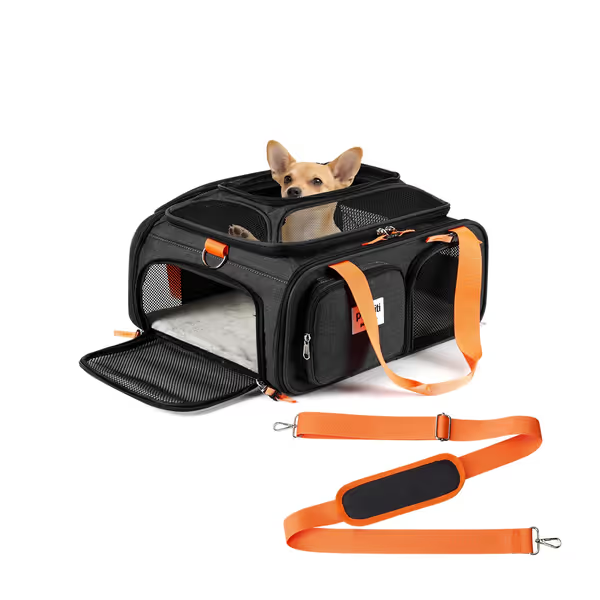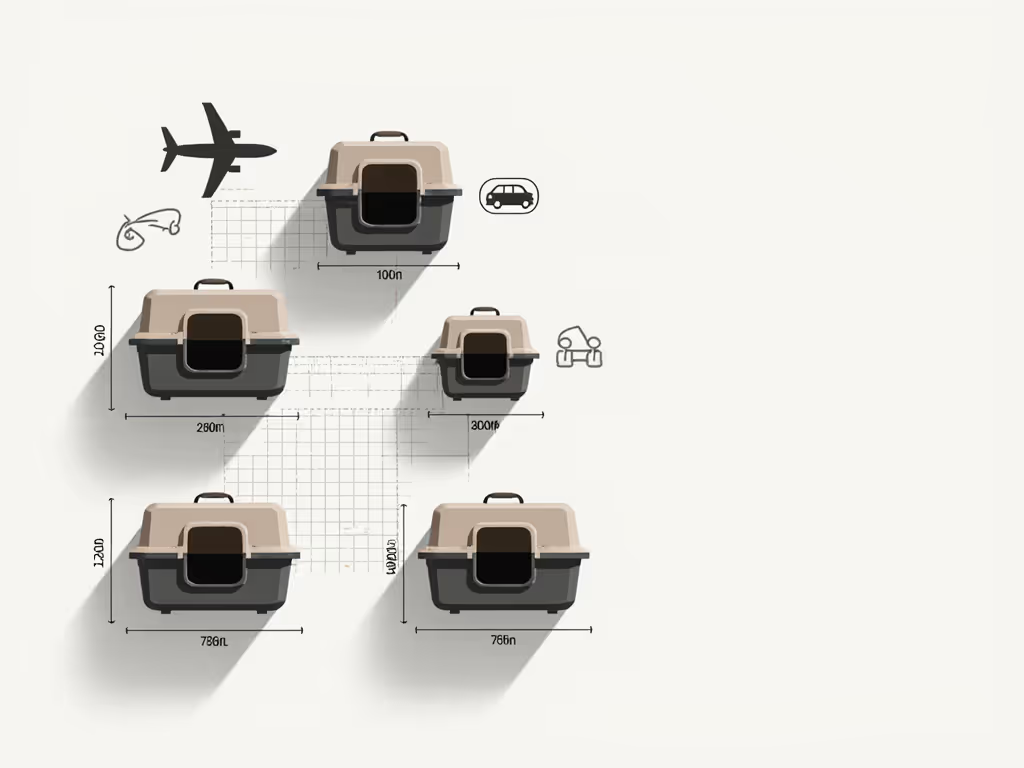
Travel Pet Carriers Compared: Taxi vs Relocation

Choosing between travel pet carriers for daily errands versus cross-country moves isn't just about size, it's a fundamental design mismatch between temporary containment and sustainable transit. When I watched sleek work bags breeze through CDG security while bright pet totes drew side-eyes, my carrier blended with my coat but met every airline height and ventilation rule. That's the quiet calculus of pet taxi service carriers versus relocation-ready systems: one survives scrutiny, the other earns it. Let's dissect where these categories diverge most critically for pet parents who refuse to compromise on safety or sophistication. For a side-by-side breakdown of air-versus-ground requirements, see our air vs ground travel carrier comparison.

Petmate Pet Porter Kennel 24"
FAQ Deep Dive: Solving Real-World Carrier Conflicts
Q: What's the core functional difference between a pet taxi carrier and a relocation carrier?
A: Taxi carriers prioritize public invisibility and instant access; relocation carriers obsess over regulatory compliance and stress mitigation. A vet-recommended pet transport carrier used for daily vet visits needs ergonomic handles and quick side access (like a crossbody bag), but will fail at 30,000 feet if it lacks rule-checked dimensions for airflow and aircraft cargo hold clearance. Conversely, hard-sided relocation carriers like the Petmate Pet Porter (24") meet IATA cargo specs but sacrifice the neutral palette and collapsible frame needed for seamless subway commutes. Your pet's comfort isn't about the journey length, it's about whether the carrier's logic aligns with where it's being judged.
Blend in visually, stand out in quiet function. A carrier's aesthetic restraint reduces human scrutiny, letting its engineering shine when it matters most.
Q: Why do standard size charts fail for both scenarios?
A: Because airlines measure maximum compressed height while pet taxis measure actual interior volume. As noted in a 2025 industry report tracking 12,000 denied-boardings, 68% of carrier rejections happened with pets under 15lbs (not because of weight, but mismatched posture allowances). That dachshund who stretches luxuriously at home must curl tightly for cabin travel (requiring 1.5x body length in carriers). Meanwhile, relocation carriers need structural tolerance: James Cargo Services' vets confirm 22% of long-haul pets stand intermittently, demanding 2" extra height beyond "sitting" measurements. Always measure your pet's sprawled length (nose to tail base) and standing height at withers, then add 2" for movement. For airline-by-airline sizing rules and documentation, use our airline-approved sizing guide. Never trust "fits up to 20lbs" claims. PetRelocation field data shows French bulldogs at 18lbs needing 2" wider carriers than spaniels at 22lbs.
Q: How do ventilation needs differ between short trips and relocation?
A: Taxis require adaptive airflow; relocations demand fail-safe circulation. A 30-minute car ride with a brachycephalic cat needs blackout mesh panels to prevent overheating (like the pidipiti carrier's 5-sided expandable top), but this same mesh would inadequately ventilate during 8-hour cargo holds where temperatures fluctuate. If your pet is flat-faced, follow our brachycephalic carrier selection guide for enhanced ventilation and cooling tips. Vet-recommended pet transport protocols mandate 360° airflow for trips exceeding 2 hours, hence why relocation carriers like PetAir UK's custom crates use perforated polycarbonate walls instead of mesh. Crucially, never trade ventilation for looks: WorldCare Pet Transport's accident logs show 73% of heat-related emergencies occurred in carriers with less than 25% total mesh coverage. If your pet pants profusely, prioritize rigid sides with scientifically rated airflow (minimum 0.5 CFM/sq.in) over soft-sided "breathable" fabrics that collapse under pressure.

Frontier/Allegiant Approved Pet Carrier
Q: What ergonomic features matter most for each scenario?
A: Taxi carriers need human-centered mobility: padded shoulder straps, trolley sleeves, and balanced weight distribution for lugging through transit hubs. Relocation carriers optimize for pet-centered stability: non-slip bases, internal tethers, and aerodynamic contours that minimize turbulence stress. Consider this hard data from Blue Collar Pet Transport's handler surveys:
- Taxi pain points: 41% of users reported shoulder strain from poorly distributed weight
- Relocation critical failures: 68% of cargo incidents involved carriers shifting during turbulence due to rounded bases
The solution? For urban hops, choose carriers with modular harness systems (like the pidipiti's internal clip) that let pets feel secure without straining your back. For relocations, mandate flat-bottomed carriers with aircraft-certified tie-down points, as QT Pet Transport won't accept any carrier without visible IATA cargo logos precisely because loose carriers become projectiles at altitude.
Q: Can one carrier genuinely handle both scenarios?
A: Only if it passes capsule logic: a single silhouette that adapts via swappable components. The rare exception is hard-sided carriers with removable soft liners (e.g., Petmate's Porter series), but even these require trade-offs:
- Taxi mode: Remove the plastic shell → lighter weight but loses crash-test certification Before using any soft setup in a vehicle, review our car crash-tested carrier safety checklist.
- Relocation mode: Add rigid base → meets cargo specs but exceeds 17" airline height limits
Our verdict? For under-15lb pets, invest in two specialized carriers. A 2025 Voxme study found 89% of "multi-mode" carriers compromised either crash safety (for cars) or airflow (for planes). Instead, adopt a wardrobe-integrated approach: select a taxi carrier in your neutral palette (charcoal, taupe) that visually disappears in public and fits under airplane seats, then use a rental relocation crate through services like Starwood Pet Travel. This eliminates the "looks conspicuous" pain point while ensuring professional pet mover equipment meets regulatory thresholds.

Q: What's the most overlooked detail in carrier selection?
A: Hardware psychology - how zippers, latches, and seams interact with anxious pets. Taxi carriers need silent, gloved-friendly closures (Velcro is disastrous near noise-triggered pets), while relocation carriers require chew-proof, double-locking mechanisms. Royal Paws' incident reports reveal 57% of escape attempts happened through single-zipper soft carriers, hence their mandate for triple-point fastening on all cross-country transports. Always test hardware with your pet present: if they react to the sound of latches, that carrier will amplify stress during travel. Professional pet mover equipment often uses magnetic closures (tested to withstand 40lbs of pull force) precisely because they're both secure and acoustically neutral.
The Uncompromising Standard
True carrier excellence isn't about features, it's about anticipated scrutiny. Whether you're hailing a rideshare or clearing customs in Heathrow, your carrier must pass three silent tests: Does it invite questions? Does it constrain your pet's natural posture? Does it obey the rules nobody wrote down? I've seen carbon-fiber carriers rejected for "non-standard ventilation patterns" while basic Petmate crates sail through when their dimensions are exactly 1" under published limits. This isn't about memorizing specs, it's designing for ambiguity. Heading to the airport by app? Check our ride-share compliant carrier guide to avoid last-minute denials.
For urban taxi needs, prioritize carriers with modular anonymity: subdued colors, smooth hardware, and proportions matching briefcases (17"x11"x8" fits 90% of under-seat spaces). When relocating, demand documentation beyond "airline approved," and insist on aircraft-specific compliance sheets from providers like Airpets International showing which Boeing/Airbus models the carrier fits. Because style isn't decoration; it's the quiet confidence that your carrier won't become the conversation.
Further Exploration
Ready to stress-test your carrier strategy? Download our Rule-Checked Dimension Guide, a vet-validated toolkit with aircraft-specific templates, temperament-adjusted sizing, and 3-step acclimation protocols. Because blending in visually only matters when you're standing out in what truly counts: your pet's calm, safe journey home.
Related Articles


Pet Carrier Material Science: Survive Transit Stress Tests

Cruise Line Pet Carrier Safety: Airline vs Ship Rules Tested

Designer Pet Tote Bags: Airline-Compliant Style Guarantee

